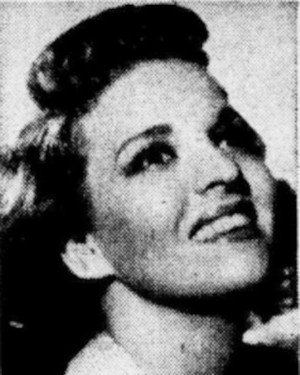Judy Ellington
aka Dottie Lee
Singer Judy Ellington had her moment of fame in 1939. In the right place at the right time, she found herself in the national spotlight when Charlie Barnet’s band broke out as one of the major swing orchestras in the country. She was unable to follow-up on that popularity, however, and quickly drifted into obscurity after leaving the band.
A native of Raleigh, North Carolina, Ellington headed to Washington, D.C., at the end of 1933, where she landed a job with Bill Strickland’s orchestra at the Lotus. The blonde vocalist spent more than two-and-a-half years at the club before leaving in late 1936 to join Russ Morgan, traveling with his band for six months. Ellington then joined Rudy Vallee in early 1937, where she was billed as Dottie Lee. She stayed with Vallee for a year-and-a-half before becoming part of Barnet’s group by October 1938, changing her name back to Ellington.
Barnet had led a jazz orchestra since late 1934 but had never found great success. In 1938, while the band toured across the country, he began to quietly revamp his sound, bringing in new musicians and vocalists, including Ellington. When they turned up at the Famous Door in New York on January 17, 1939, the quality of Barnet’s new outfit surprised and amazed both patrons and critics, and the group quickly began to attract attention, signing with Bluebird and releasing a series of well-received recordings that year, many of them featuring Ellington. She proved highly popular with jazz fans, her voice sometimes compared to Billie Holiday.
In late October, Barnet fans at the University of Kansas expressed their displeasure when Ellington missed a show with the official excuse that she had an attack of appendicitis.[1] One student reported that he saw her exiting the building later that night. Both she and Barnet male vocalist Larry Taylor left the band in November and joined Tommy Reynolds. Ellington stayed with Reynolds only briefly, leaving in December with illness being the reason given. In January 1940, she was with Sonny James, and in February she was solo on the vaudeville circuit, working with, according to one source, the “Dead End” kids. In March, she appeared on NBC radio, and in June she recorded with Buster Bailey’s band. She made another appearance on NBC, as part of the Battle of the Sexes, in January 1941.
In early 1942, Ellington was part of the show at a Pittsburgh theater. In October, she returned to Washington, D.C., where she sang with Blue Barron’s band for a special Halloween show. She remained in the city afterwards, taking up residence at Paul Young’s, a local club, where she stayed through January 1943. At some point after, Ellington married a Scotsman and retired in New York, the couple having their first child, a daughter, by late 1945, when Ellington briefly came out of retirement to sing at the twelfth anniversary of the Lotus. She remained at the Lotus for three weeks before returning to New York. She had a second daughter by summer 1948, when she made a final comeback attempt, appearing at the Capitol Theater in Washington. An engagement at the Merry-Land Club followed. Ellington then disappears into the mists of history.
Notes
Whether she actually had appendicitis or not is unknown. Appendicitis was a typical excuse given for a female vocalist’s absence when they wished the true reason to remain private. ↩︎
Sources
- “Judy Ellington.” The Washington, D.C., Star 27 Oct. 1938: C-7.
- “Mrs. Walter Noble New President Of Ladies' Auxiliary.” Red Bank Register [Red Bank, New Jersey] 24 Nov. 1938: 1.
- “The Reviewing Stand: Charlie Barnet.” Billboard 28 Jan. 1939: 15.
- “Barnet and 'Cafe Society' Thrill N.Y.” Down Beat Feb. 1939: 3.
- “After Dark.” The Washington, D.C., Star 23 Feb. 1939: B-11.
- “Vaudeville Reviews: Paramount, New York.” Billboard 1 Apr. 1939: 22.
- Lewis, John. “Sidelights On Prom Musicians.” The Washington, D.C., Star 5 May 1939: 1.
- MacArthur, Harry. “Judy Ellington Tops Stage Doings by Charlie Barnet.” The Washington, D.C., Star 20 May 1939: B-16.
- Advertisement. “Charlie Barnet and his Orchestra.” Down Beat Jul. 1939: 26.
- “Formal Attire for the K.U. Pep Rally.” Lawrence, Daily Journal-World [Lawrence, Kansas] 21 Oct. 1939: 2.
- “Orchestra Notes.” Billboard 2 Dec. 1939: 20.
- “Carnival Ball Will Again Be Formal.” Middlebury Campus [Middlebury, Connecticut] 13 Dec. 1939: 1.
- Hendrickson, Verna. “Dorothy Maynor Recording Made.” Berkeley Daily Gazette 20 Dec. 1939: 8.
- Advertisement. “Westwood Supper Club.” The Richmond Collegian [Richmond, Virginia] 12 Jan. 1940: 4.
- “Carnival Ball, Klondike Rush Plans Finished.” Middlebury Campus [Middlebury, Connecticut] 24 Jan. 1940: 1.
- “Reynolds Band Follows Trail Of Big Names.” Middlebury Campus [Middlebury, Connecticut] 7 Feb. 1940: 1.
- “After Dark.” The Washington, D.C., Star 15 Feb. 1940: B-8.
- Damai, Paul K. “Radio.” Billboard 3 Mar. 1940: 4.
- McJimsey, Ilyne. “The Dial Log.” Austin Daily Texan 28 Jan. 1941: 3.
- “Club Talent: Here and There.” Billboard 7 Feb. 1942: 15.
- “Barron's Band To Celebrate Halloween.” The Washington, D.C., Star 25 Oct. 1942: E-2.
- “After Dark.” The Washington, D.C., Star 27 Oct. 1942: A-14.
- “After Dark.” The Washington, D.C., Star 29 Oct. 1942: B-18.
- “After Dark.” The Washington, D.C., Star 12 Nov. 1942: C-12.
- “After Dark.” The Washington, D.C., Star 12 Jan. 1942: B-14.
- “Night Club Reviews: Paul Young's, Washington.” Billboard 27 Feb. 1943: 12.
- “After Dark.” The Washington, D.C., Star 8 Nov. 1945: B-13.
- “After Dark.” The Washington, D.C., Star 15 Nov. 1945: A-19.
- Advertisement. “Capitol.” The Washington, D.C., Star 8 Jul. 1948: B-12.
- MacArthur, Harry. “After Dark.” The Washington, D.C., Star 24 Aug. 1948: A-10.
- “After Dark.” The Washington, D.C., Star 2 Sep. 1948: B-10.
- “After Dark.” The Washington, D.C., Star 25 Nov. 1948: A-23.
